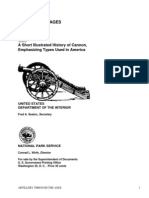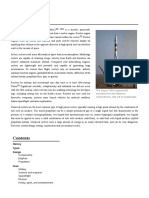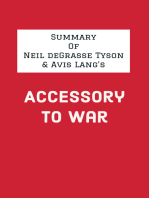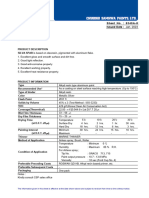The History of Rocketry
The History of Rocketry
Uploaded by
777serj777Copyright:
Available Formats
The History of Rocketry
The History of Rocketry
Uploaded by
777serj777Copyright
Available Formats
Share this document
Did you find this document useful?
Is this content inappropriate?
Copyright:
Available Formats
The History of Rocketry
The History of Rocketry
Uploaded by
777serj777Copyright:
Available Formats
THE HISTORY OF ROCKETRY:
FROM FIREWORKS TO THE MOON
At first glance you might think that there couldn't possibly be anything in common between a 13th century festival in China and the Apollo 11 moon landing in 1969. However there is a link and that is that they both relied on the use of rockets. The Chinese first developed rockets by filling bamboo tubes with an explosive made from saltpetre, charcoal, and sulphur. The sealed tubes would be thrown onto fires during celebrations because it was thought that the loud explosions would protect them. When these tubes were not perfectly sealed though they would fly out of the fire and could explode some distance away. It wasn't long before the ancient Chinese realised the military potential of these devices and primitive rockets were used to repel a Mongol invasion in 1233 AD. Word of these amazing new weapons quickly spread around the world and soon rockets were being used in military operations in North Africa and Europe. During the 15th and 16th centuries they were widely used in naval battles to set fire to enemy ships. Around this time they also started being used for more peaceful purposes again. In 16th and 17th century Euro firework displays using rockets became a very popular form of public entertainment. In the late 18th century the British army suffered two serious defeats at battles in Seringapatam, in India, the mam reason for these defeats was that the Indian prince, Haidar Ali's army included 20 a corps of rocklt throwers. They used veiy large bamboo rockets which had a range of hundreds of metres.The British were determined to learn from their mistakes and a British officer, William Congriem began work on developing even bigger and better rockets. Within a few years Congrieve had developed 14 kg iron rockets that could be fired over 3200m. These rockets were successfully used against Napoleon at the battle of Waterloo and during the US War of Independence. By the 1880s other applications for rockets were being developed. They were used for signallinsEor whaling, and even for rescuing people from sinking ships. If a boat got into trouble near to the shore, a rocket with a thin rope tied to it would be fired out over the boat, survivors in lifeboats could use the ropes to pull themselves ashore. These traditional rockets are still used as distress signals on boats and planes. However in the 1920s and 30s a great leap forward in the use of rockets took place with the introduction of liquid fuel. This made rockets much more powerful. The new rockets were so impressive that for the first time people began to seriously think about using rockets to take people into space. It didn't take long for these dreams to become a reality. In the 1950s the Soviet Union and 35 the USA invested large amounts of money in their new space programmes. This lead to the . launch of Sputnik 1, the first artificial satellite, by the USSR in 1957. Less than a month later I they followed this with Sputnik 2 which carried a dog, Laika, into orbit. The USA sent its first | satellite, Explorer 1, into space early the nex| year. The next step, putting a man in space \ followed in 1961 when Yuri Gagarin orbited the Earth in Vostok 1. Eight years later Neil 40 Armstrong took those famous first steps on the; lunar surface. This was possibly mankind's f greatest scientific achievement and it was all due to rockets whose basic design had been I thought up hundreds of years before.
You might also like
- المعاملة الوالدية وأثرها على التحصيل الدراسي للابناءDocument12 pagesالمعاملة الوالدية وأثرها على التحصيل الدراسي للابناءIssam Eddine ChabakouniNo ratings yet
- The Space Race: How the Cold War Put Humans on the MoonFrom EverandThe Space Race: How the Cold War Put Humans on the MoonNo ratings yet
- Back Testing With 99 Percent Modelling V1Document4 pagesBack Testing With 99 Percent Modelling V1drakko_mxNo ratings yet
- King Air in IndiaDocument10 pagesKing Air in Indiavikash_kumar_thakur0% (1)
- RocketDocument15 pagesRocketAayush BansalNo ratings yet
- Week 2 Midterm Lecture No. 1Document18 pagesWeek 2 Midterm Lecture No. 1Aaron CasinoNo ratings yet
- Amity University: History of Rockets and MissilesDocument63 pagesAmity University: History of Rockets and Missilessaunty125No ratings yet
- T Brief History Of: Hero EngineDocument15 pagesT Brief History Of: Hero EngineindraNo ratings yet
- Brief History of RocketsDocument5 pagesBrief History of RocketsFeby Philip AbrahamNo ratings yet
- Unit 1 SPDocument105 pagesUnit 1 SPUSERANo ratings yet
- Project On Transport Yash..... Do Not Dealet It ..........Document4 pagesProject On Transport Yash..... Do Not Dealet It ..........Mradul PalNo ratings yet
- STS SpeechDocument28 pagesSTS SpeechMARTIN CRAIG FOZNo ratings yet
- Activity 3 StsDocument19 pagesActivity 3 Stsolasiman.erickajane.tNo ratings yet
- Rocket: Dear Wikipedia Readers: ToDocument50 pagesRocket: Dear Wikipedia Readers: ToHailin ArumigaNo ratings yet
- History of TransportationDocument13 pagesHistory of TransportationJoseMelarte GoocoJr.No ratings yet
- Artillery Through the Ages A Short Illustrated History of Cannon, Emphasizing Types Used in AmericaFrom EverandArtillery Through the Ages A Short Illustrated History of Cannon, Emphasizing Types Used in AmericaNo ratings yet
- A Pictorial History of RocketsDocument12 pagesA Pictorial History of RocketsDiaz Ing ToretoNo ratings yet
- STS Group 2Document50 pagesSTS Group 2Joana MarieNo ratings yet
- History of TransportationDocument9 pagesHistory of TransportationRajesh KhadkaNo ratings yet
- Life from Above: Epic Stories of the Natural WorldFrom EverandLife from Above: Epic Stories of the Natural WorldRating: 4.5 out of 5 stars4.5/5 (2)
- SPace ExplorationDocument1 pageSPace ExplorationBaže PalitovNo ratings yet
- Introduction To The Space AgeDocument16 pagesIntroduction To The Space AgeAnne MillbrookeNo ratings yet
- Rocketry HistoryDocument37 pagesRocketry HistoryarravindNo ratings yet
- Kata 1 ROKETDocument3 pagesKata 1 ROKETLeoNo ratings yet
- Artillery Through The AgesA Short Illustrated History of Cannon, Emphasizing Types Used in America by Manucy, AlbertDocument81 pagesArtillery Through The AgesA Short Illustrated History of Cannon, Emphasizing Types Used in America by Manucy, AlbertGutenberg.org100% (8)
- The Space AgeDocument18 pagesThe Space AgeLaura CarvalhaisNo ratings yet
- Assignment 1 - Andaya - HREDocument7 pagesAssignment 1 - Andaya - HREdariel.andayaNo ratings yet
- The Rocket - : From East To WestDocument15 pagesThe Rocket - : From East To Westsushainkapoor photoNo ratings yet
- How the Victorians Took Us to the Moon: The Story of the 19th-Century Innovators Who Forged Our FutureFrom EverandHow the Victorians Took Us to the Moon: The Story of the 19th-Century Innovators Who Forged Our FutureNo ratings yet
- Assignment 1 - 222 FinalDocument4 pagesAssignment 1 - 222 FinalAbdulRahmanNo ratings yet
- FullDocument16 pagesFulllewoj24900No ratings yet
- Rocket: History Types DesignDocument22 pagesRocket: History Types DesigncruzleenoNo ratings yet
- 1 Million Years Ago: FireDocument5 pages1 Million Years Ago: FireMade W KamasanNo ratings yet
- Myanmar Aerospace Engineering University: Development of Rocket TechnologyDocument48 pagesMyanmar Aerospace Engineering University: Development of Rocket TechnologyZaw Min TunNo ratings yet
- Neil Armstrong: The Success of Apollo 11 and the First Man on the MoonFrom EverandNeil Armstrong: The Success of Apollo 11 and the First Man on the MoonNo ratings yet
- Space Race Essay RoughDocument8 pagesSpace Race Essay RoughHarry HolsteinNo ratings yet
- History of Space Flight PDFDocument9 pagesHistory of Space Flight PDFErie FujitaNo ratings yet
- Shaibu Space TravelDocument19 pagesShaibu Space TravelgreatgeniusNo ratings yet
- A Student Guide To The Principles of SpaceDocument20 pagesA Student Guide To The Principles of Spaceapi-3827338No ratings yet
- Space Exploration History Lecture OneDocument10 pagesSpace Exploration History Lecture OneKiran RajuNo ratings yet
- Rocket - WikipediaDocument132 pagesRocket - WikipediaperoperoxNo ratings yet
- Army Wings: A History of Army Air Observation Flying, 1914–1960From EverandArmy Wings: A History of Army Air Observation Flying, 1914–1960No ratings yet
- RocketsDocument9 pagesRocketsapi-338900874No ratings yet
- A Brief History of Space ExplorationDocument3 pagesA Brief History of Space ExplorationMaricar Briones PalmonesNo ratings yet
- The Space RaceDocument15 pagesThe Space RaceRadu Petrusan100% (1)
- The Soviet AND The U.S MissionsDocument13 pagesThe Soviet AND The U.S MissionsGayathri KappagantulaNo ratings yet
- The Warbots by Larry ToddDocument20 pagesThe Warbots by Larry ToddScribdSucks100% (1)
- Rocket - WikipediaDocument18 pagesRocket - Wikipediainvesting.collabNo ratings yet
- ArmsRace SpaceRaceDocument3 pagesArmsRace SpaceRaceJoy YeNo ratings yet
- International Year of AstronomyDocument40 pagesInternational Year of Astronomysanj083No ratings yet
- How We Got to the Moon: The People, Technology, and Daring Feats of Science Behind Humanity's Greatest AdventureFrom EverandHow We Got to the Moon: The People, Technology, and Daring Feats of Science Behind Humanity's Greatest AdventureNo ratings yet
- SymmetryDocument17 pagesSymmetrysykstanNo ratings yet
- Interaction Designer - Josh Evnin - Resume v.2Document1 pageInteraction Designer - Josh Evnin - Resume v.2jevnin100% (1)
- RMO Assessment Form 2016Document8 pagesRMO Assessment Form 2016Tp HoangNo ratings yet
- Multi-Winding TransformerDocument10 pagesMulti-Winding TransformerTariq SharabatiNo ratings yet
- Topic 3.2 - State ReductionDocument5 pagesTopic 3.2 - State ReductionBrian OmolloNo ratings yet
- TrigonometryDocument11 pagesTrigonometryFun PlanetNo ratings yet
- Comparatives 1Document2 pagesComparatives 1NiceShot85No ratings yet
- Intro To Philo Unit 4 - Lesson 5Document14 pagesIntro To Philo Unit 4 - Lesson 5mrericksoria616No ratings yet
- UGC Net SyllabusDocument3 pagesUGC Net SyllabusKaranbirNo ratings yet
- Documentos Científicos - Andreas KalckerDocument3 pagesDocumentos Científicos - Andreas KalckerSpencer BC100% (1)
- Manual Del EDIC IONPUREDocument49 pagesManual Del EDIC IONPUREIngestructurasdelvalle Sas100% (4)
- Piping Class Spec. - 1c28pe (Lurgi)Document8 pagesPiping Class Spec. - 1c28pe (Lurgi)otezgidenNo ratings yet
- The Way of Illumination Vol 1Document207 pagesThe Way of Illumination Vol 1api-3702097No ratings yet
- Power Quality Improvement of DistributionDocument7 pagesPower Quality Improvement of DistributionVenkat SaiNo ratings yet
- Echo of Mary Queen of PeaceDocument17 pagesEcho of Mary Queen of PeaceMunteanDoliSiAtatNo ratings yet
- Rule 116 - Case DigestDocument5 pagesRule 116 - Case DigestEhlla MacatangayNo ratings yet
- Low Voltage Range of Cables - June 2014Document80 pagesLow Voltage Range of Cables - June 2014Irfan Ari PNo ratings yet
- Delhi Voter Inquiry DetailsDocument3 pagesDelhi Voter Inquiry DetailsKunal1328No ratings yet
- T S Eliot-Popular CultureDocument16 pagesT S Eliot-Popular Culturebharan16No ratings yet
- Microscópio Leica DM1000 LED - Manual Usuário - InglesDocument178 pagesMicroscópio Leica DM1000 LED - Manual Usuário - Inglesengclin.hc2No ratings yet
- The Effect of DomesDocument5 pagesThe Effect of DomesStart إبدأNo ratings yet
- Instruction Manual Edc 2: Compressed Air DryersDocument17 pagesInstruction Manual Edc 2: Compressed Air DryersTamNo ratings yet
- Clinical Field Experience CDocument5 pagesClinical Field Experience CPriscilla BoggessNo ratings yet
- Sales-I Onboarding ChecklistDocument1 pageSales-I Onboarding ChecklistRaff LimNo ratings yet
- 15 Isomerism Formula Sheets Getmarks AppDocument6 pages15 Isomerism Formula Sheets Getmarks AppPranav DasariNo ratings yet
- 8340a Silva Spar (2301)Document2 pages8340a Silva Spar (2301)4canNo ratings yet
- #1 Standard 4W Mini-Passenger SKD CKD2 FinalDocument16 pages#1 Standard 4W Mini-Passenger SKD CKD2 Finalnatan makuNo ratings yet

























































































